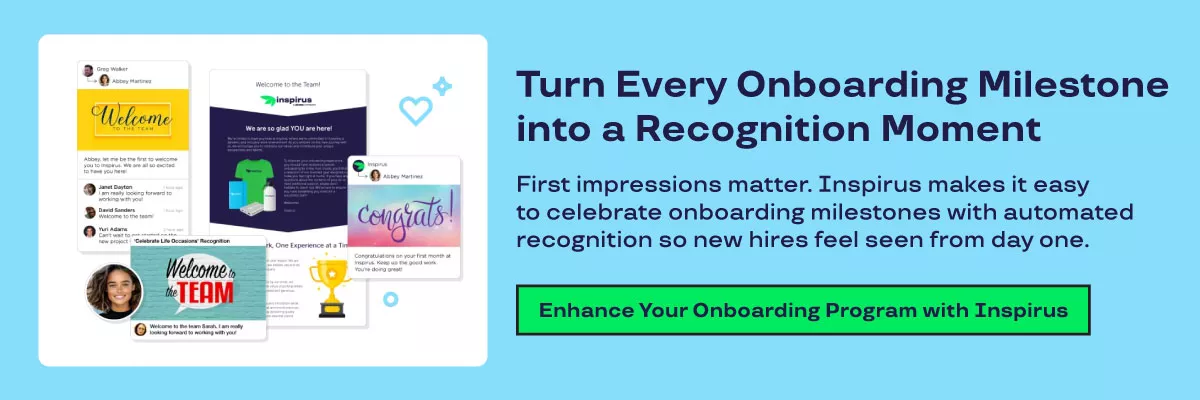
Remote Onboarding: How to Build Connection and Engagement from Day One
August 20, 2025
Set your remote new hires up for success. Learn how to keep them engaged and motivated with effective onboarding strategies and milestone recognition.
Getting and keeping employees engaged from Day One is always a challenge — and it’s even harder when they’re remote. Employee onboarding is a critical part of the talent acquisition process, a time when new hires are set up for success in both tangible and intangible ways. They’re not only learning the skills needed for their new role, but also acclimating to company culture, connecting with teammates and setting up the tools and resources they’ll need to succeed.
A strong onboarding program makes these steps smoother, but when a new hire is remote, the many moving parts can add stress for both employees and HR teams. That’s why remote onboarding requires thoughtful planning and people-centered strategies.
The Lasting Impact of Onboarding
Employee onboarding the first step in every employees' journey. It's the moment that sets the tone for their entire experience with your company. A smooth, supportive onboarding process signals to new hires that they're valued, supported and part of something meaningful. On the other hand, a disorganized or impersonal onboarding can leave them second-guessing their decision to join before they’ve even settled in.
That’s why onboarding has such a direct impact on employee engagement and retention. When employees feel connected to the culture, understand expectations and receive the tools they need to succeed, they’re far more likely to be motivated and committed long term. And the numbers back it up:
- Employees who attend a structured orientation program are 69% more likely to remain at the company for at least three years.
- Organizations with a strong onboarding process enjoy upwards of 70% higher productivity.
- Effective onboarding can increase retention by as much as 82%.
Despite these outcomes, many organizations still reduce onboarding to paperwork and policies. Without a comprehensive program that goes beyond documentation, new hires miss out on the connection, clarity, and confidence they need to thrive.
A holistic approach — one that blends logistics with culture, communication and recognition — creates a stronger employee experience from day one and establishes the foundation for long-term engagement and retention.
Common Challenges with Remote Onboarding
Remote onboarding comes with unique hurdles that don’t exist in traditional in-office settings. If left unaddressed, these gaps can leave new hires feeling disconnected and unprepared:
- Isolation and Disconnection: Without hallway chats or in-person welcomes, remote employees can feel invisible or excluded.
- Communication Breakdowns: Misunderstandings are more likely without clear guidelines on when to use email, chat or video calls.
- Tech Troubles: From late equipment deliveries to login issues, technology frustrations on day one can set a negative tone.
- Culture Gaps: Remote employees miss out on observing culture firsthand. Without intentional effort, they may struggle to grasp values, norms and “how things really get done.”
- Unclear Expectations: Without structured guidance, new hires can feel unsure about their role, priorities and success measures.
Acknowledging these challenges upfront is the first step. The next is building intentional strategies that bridge these gaps and help remote employees feel supported from day one.

6 Strategies to Keep Remote New Hires Engaged from Day One
#1 Assign a Peer Ambassador
Lack of physical proximity makes it especially important to assign remote employees a peer ambassador who can help them navigate the organization and ensure they don’t feel isolated or disconnected. A Peer Ambassador is not a mentor, but a co-worker who acts as a “go-to” resource for all the little questions that are bound to come up as they start their new job. Introduce the new employee to their peer ambassador on Day One and allow some time for them to connect.
The ambassador can also play a role in introducing the new employee to others they will be working with, connecting them virtually and explaining the company structure and relationships at the same time. Maintain this formal peer ambassador relationship for the employee’s first six months, with touchpoints diminishing over time from daily to weekly to monthly as the employee becomes acclimated and gains confidence.
#2 Planting the Seeds for Growth
Personal growth and development are top drivers in employee engagement. In fact, the 2022 LinkedIn Learning Report indicates that “opportunities to learn and grow” is the #1 driver of a great work culture. The early days of onboarding are the perfect window for employees to spot where those opportunities might exist and how they can grow in their new role.
And while it may seem counterintuitive to introduce growth conversations during an already busy onboarding process, it’s actually the ideal time to plant the seed for future development and long-term engagement.
#3 Devote Time to Tech
Getting new employees set up with the technology they need to be productive is an entirely different process when they’re working remotely and needs to be approached proactively. New hires in physical offices generally find that their computer equipment is set up and ready for them to go on their first day. That’s not the case with most remote workers. Many may, in fact, be tasked with setting up their own equipment.
Ship computers to remote employees preloaded with the resources they’ll need and offer an IT professional’s time to help them set everything up, step-by-step, ensuring that they’ll get things right the first time and avoid frustration. Even tech-savvy millennials — and tech native Gen Z employees — are likely to have some questions.
#4 Surprise Them with a Swag Bag on Day Zero
Even before your new remote employees formally start their jobs, you can help make them feel welcome by sending them a branded swag bag filled with company products, the employee handbook (either printed or accessible through a QR code), along with a handwritten note to help punctuate the excitement you feel for having them on board. Encourage new employees to also share their excitement by promoting their new role through their social media channels to amplify inclusion and spread positive vibes.
#5 Schedule Onboarding Meetings
Announce new hires internally before they start so the entire workforce knows who is starting, when and what role they play. Coordinate structured onboarding meetings with the team members and subject matter experts (SMEs) on tools and processes they will need to use on Day One, so that they get the right information from the right people at the right time. A strong onboarding process helps to engage and retain employees from their first day of employment.
Don't forget to encourage remote employees to be proactive in making connections. Remote employees may feel they need “permission” to reach out to others on their own — especially those co-workers who may be in higher level positions or belong to other work teams. Remove these barriers by making it clear that you encourage employees to reach out and engage with others as often as they’d like.
#6 Check In with New Hires Regularly
Stay closely connected to your new remote employees as they settle in. Regular check-ins give you the chance to see how they’re adjusting, answer questions, and address any challenges before they grow into bigger issues. Use these conversations to make sure they have the resources and connections they need to succeed, and introduce them to the right people internally when additional support is needed.
Employee onboarding is one of the most influential drivers of a positive employee experience. For remote employees in particular, consistent communication shows that they’re valued, engaged and not on their own. Getting this right early builds momentum and sets the stage for a successful, long-term employee journey.
Recognizing Important Employee Onboarding Milestones
One of the most powerful (and most overlooked) ways to support remote employees is through recognition. Without the casual in-office kudos, new hires can easily feel invisible. Recognition fills that gap by reinforcing progress, boosting motivation and fostering belonging.
Here’s how to integrate recognition into the remote onboarding journey:
- Day One Welcome: Kick things off with energy. Encourage managers and peers to send personalized welcome messages through your recognition platform. Add a shoutout during the team’s first meeting or a small gift (digital or physical) to make them feel instantly included.
- 30 Days: By the one-month mark, employees are starting to get their footing. Recognize early wins like completing training modules, learning systems or contributing to their first small project. This builds confidence and reinforces that they’re on the right track.
- 60 Days: Around two months in, employees begin to take on bigger responsibilities. Acknowledge milestones like their first time presenting work to the team or applying company values in action.
- 90 Days: At three months, most new hires start to transition from “new” to “part of the team.” Celebrate the milestone with a more formal acknowledgment like a shoutout from leadership or a reward. This cements belonging and highlights their progress in a tangible way.
- First-Year Anniversary: A year in, it’s time to celebrate everything they’ve achieved. Personalize the recognition with something meaningful, such as reward points they can redeem for a gift of choice or a public acknowledgment of their contributions. Recognition at this stage keeps engagement strong and sets the tone for long-term retention.
Employee recognition platforms like Inspirus Connects make this process easy for HR. With automated milestone celebrations, no achievement or milestone slips through the cracks, ensuring remote employees feel supported and valued from day one.
When recognition is woven into the remote onboarding process, it closes the gap left by the lack of in-person interactions. It not only strengthens connection in the early days, but also creates a culture where remote employees feel consistently appreciated and connected, no matter where they’re working.

Strong Remote Onboarding = Strong Employee Experience
Remote onboarding comes with unique challenges, but with the right strategies, you can transform it into a powerful employee engagement tool. When employees feel seen, supported, and connected early on, they’re more motivated and more likely to stay for the long haul.
From day-one welcomes and peer support to clear communication and milestone recognition, every step builds trust and belonging. Get it right and you are not only helping employees ramp up faster, you are also shaping a positive employee experience that drives employee retention, engagement and culture well beyond the first 90 days.




